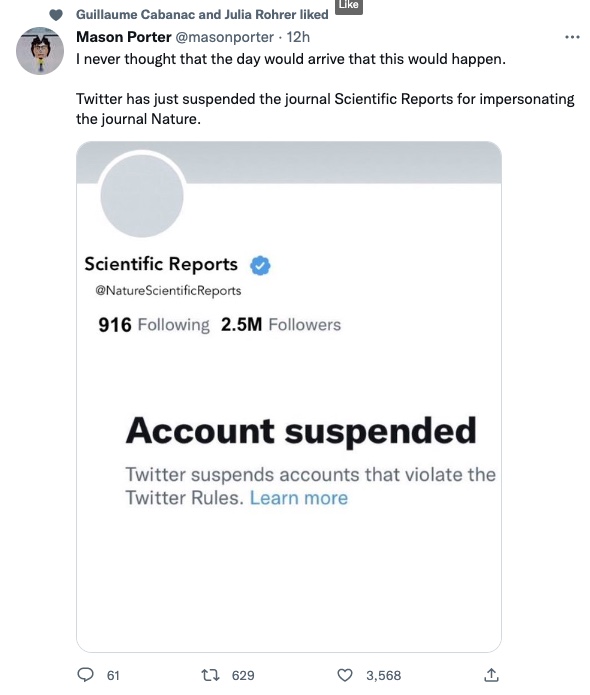OK, here we are, it was a nightmare from the preprint in April 2021 with basically 100 emails until the publication in March 2023.
OK, here we are, it was a nightmare from the preprint in April 2021 with basically 100 emails until the publication in March 2023.
Das große Karthago führte drei Kriege.
Es war noch mächtig nach dem ersten,
noch bewohnbar nach dem zweiten.
Es war nicht mehr auffindbar nach dem dritten.
Bertolt Brecht zugeschrieben aber könnte genauso auch von der unvergessenen Helene Weigel stammen.
Dirnagl/LJ hat die Antwort
Besteht die Lösung des Problems also darin, Wissenschaftsbetrug härter zu sanktionieren? Schaden würde das sicher nicht. Schließlich kann man die Fälle, in denen bislang Strafen verhängt wurden, an einer Hand abzählen. Wissenschaftsbetrug wird also nicht nur selten aufgedeckt, sondern noch seltener geahndet.
Müssen wir mehr gute wissenschaftliche Praxis lehren und trainieren? Auch das ist eine gute Idee, aber sehr viel nützen wird es wohl nicht. …
Brauchen wir vielleicht eine Wissenschaftspolizei, die unangekündigte Kontrollen von Western Blots und Festplatten in Laboren durchführt? Ganz sicher nicht! Moderne Wissenschaft ist viel zu komplex …
Ein viel naheliegender Ansatz zur Abhilfe ist es, sich dem Kern des Problems anzunehmen und das toxische Karriere- und Bewertungssystem zu reformieren – also Forscher nicht auf Basis fragwürdiger Metriken, sondern mit Fokus auf Forschungsqualität, Inhalte und dem tatsächlichen wissenschaftlichen oder gesellschaftlichen Impact zu beurteilen.
You ask me how I became a madman. It happened thus: One day, long before many gods were born, I woke from a deep sleep and found all my masks were stolen,
the seven masks I have fashioned and worn in seven lives,
I ran maskless through the crowded streets shouting, “Thieves, thieves, the cursed thieves.”
Men and women laughed at me and some ran to their houses in fear of me.
And when I reached the market place, a youth standing on a house-top cried, “He is a madman.” I looked up to behold him; the sun kissed my own naked face for the first time. For the first time the sun kissed my own naked face and my soul was inflamed with love for the sun, and I wanted my masks no more. And as if in a trance I cried, “Blessed, blessed are the thieves who stole my masks.”
Thus I became a madman.
And I have found both freedom and safety in my madness; the freedom of loneliness and the safety from being understood, for those who understand us enslave something in us.
But let me not be too proud of my safety. Even a Thief in a jail is safe from another thief.
While we are still waiting for the contest of the best illusions in 2022 here are my my all time favorites:
– for acoustics it is Yanny or Laurel – I hear Yaurel
– for optics it is the wedding dress – I see blue with black lace
Steht [der Begriff] unter einem Beitrag als Antwort, wird darauf hingewiesen, dass der ursprüngliche Post mehr Antworten als „Retweets“, „Likes“, „Gefällt mir“-, oder „Fav“-Angaben hat. Es kann auch verwendet werden, wenn ein „DruKo“, also eine Antwort unter einem Beitrag, mehr „Likes“ hat als der Ausgangsbeitrag. Manchmal wird auch „ratioed“ verwendet. (GIGA)
“Ratio” sollte vielleicht auch als PubMed Flag bei Zeitschriften eingeführt werden, wenn es mehr PubPeer Kommentare als Zitierungen gibt.
Nature reported yesterday a new paper by Russell Funk on research innovation or “disruptiveness”
The number of science and technology research papers published has skyrocketed over the past few decades — but the ‘disruptiveness’ of those papers has dropped, according to an analysis of how radically papers depart from the previous literature.
Data from millions of manuscripts show that, compared with the mid-twentieth century, research done in the 2000s was much more likely to incrementally push science forward than to veer off in a new direction and render previous work obsolete. Analysis of patents from 1976 to 2010 showed the same trend.
So has everything already discovered by getting most low hanging fruits (A)? Are scientists no more taking any risk (B)? Or is the “disruptive” science now hidden in the meaningless research (C)? Or did only change citation practices (D)? The answer is in the original paper
Specifically, despite large increases in scientific productivity, the number of papers and patents with CD5 values in the far right tail of the distribution remains nearly constant over time. This ‘conservation’ of the absolute number of highly disruptive papers and patents holds despite considerable churn in the underlying fields responsible for producing those works… These results suggest that the persistence of major breakthroughs—for example, measurement of gravity waves and COVID-19 vaccines—is not inconsistent with slowing innovative activity. In short, declining aggregate disruptiveness does not preclude individual highly disruptive works.
In my own words: Progress is found in the top percentiles just as many decades before. But most research publications are a waste of money and even harmful for cluttering up the research field.
There seem to be also some critical comments and of course some methodological issues need to be clarified for any further interpretation (eg exclusion of reviews, validity of the 5 year interval, …). 5 years may not be enough in some fields, medical practice doesn’t even change for a long time – see also the comment of Bruce Albert. In any case, the authors promised to give me the CD5 dataset which will be nice to look up my own work.
20 Feb 2023
Forgot to update this post as there is an option E – that the study is just describing an artefact,.. I received the dataset one week later but couldn’t verify the claims when analyzing my own “disruption score”. Upon inquiry RF said that PubMed doesn’t include citations for all papers. “So to drop these papers from the data, required that papers had at least 1 reference in their reference list, and had been cited at least 1 time”.
The numbers were however still confusing as are 2.3 million entries in the CD5 file while Pubmed had roughly 18 millions entries in 2010 according to https://www.nlm.nih.gov/archive/20110328/bsd/licensee/2010_stats/2010_LO.html.notice.html. So I asked if the discrepancy may be explained by an additional constraint? RF explained that “For the Nature paper, we only analyzed data up through 2010, for consistency with the other data sets used in the paper. But we computed the measure for more recent years” which may have led to the missing scores.
A colleague also wrote about the study later in a German magazine https://www.laborjournal.de/rubric/narr/narr/n_23_03.php basically saying that science is not disruptive, it builds nearly always on earlier ground work: “Disruptive is economic gobbledegook”.
Interestingly and only last week I learned about another much more extensive reanalysis that arrives at very similar conclusions “Dataset Artefacts are the Hidden Drivers of the Declining Disruptiveness in Science“. Holst et al. describe in this paper
Our reanalysis shows that the reported decline in disruptiveness can be attributed to a relative decline of these database entries with zero references. … Proper evaluation of the Monte-Carlo simulations reveals that, because of the preservation of the hidden outliers, even random citation behaviour replicates the observed decline in disruptiveness.
And well, there is now also a PubPeer entry but only from the last year.
Having been confronted with the “pull” doctrine now many times, I went for further literature. The best summary that I have found is by the European Asylum Support Office 2016
On the conceptual level, there are serious limitations with the commonly used (yet often critiqued) push and pull framework as an explanatory tool for migration decision-making processes … it makes strong assumptions about the way individuals respond to stimuli; it presumes that an individual can make cost/benefit decisions based on full information, in markets tending to a general equilibrium, far from the complex reality of human mobility. As such, the model fails to explain why, for instance, people respond differently to the same ‘push’ and ‘pull’ forces, and why emigration and immigration occur simultaneously in the same area.
There seem to be many more limitations than currently assumed.
factors explaining migration 1) often originate in the household/community/country of origin (e.g. unemployment, gender discrimination, conflict), while factors influencing migration 2) are more likely to be destination-specific (e.g. presence of co-ethnic community members, perception of the country as having a permissive asylum regime, language similarities) or process- specific (e.g. a smuggler has chosen a destination).
Another key issue, is the high death toll that is of course known to refugees.
Studying migration flows across the Mediterranean, particularly along two routes (the western and central Mediterranean routes), Altai Consulting found that social, political, and economic instability inspired migration flows but that individuals fleeing greater threats to their personal security were willing to traverse more dangerous and uncertain migration routes.
So we are dealing with
The report shows the relevance of migrant networks in facilitating asylum migration movements and influencing migrants’ destination choices. Going back even to an earlier report of migration direction in Science, I can’t find any evidence for any pull effect.
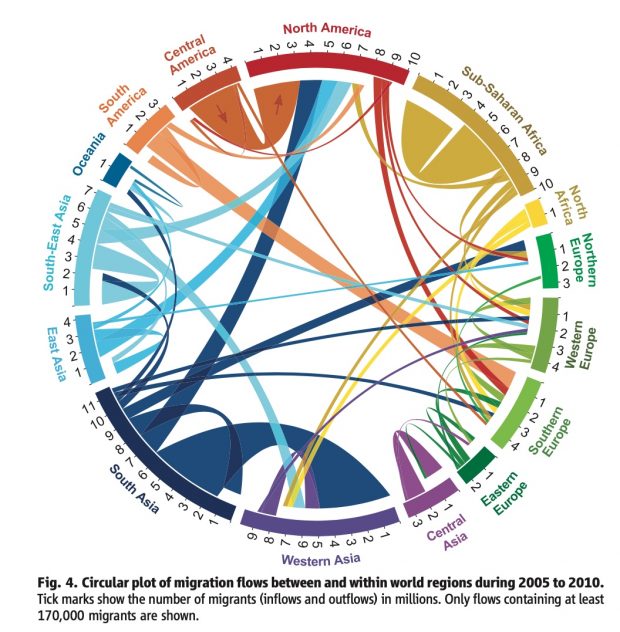
Aug 4, 2023
There is a new time series study in Sci Rep by Alejandra Rodríguez Sánchez aggregating counts of arrivals, pushbacks, and deaths adjusting for various known drivers of irregular migration via the Central Mediterranean Route
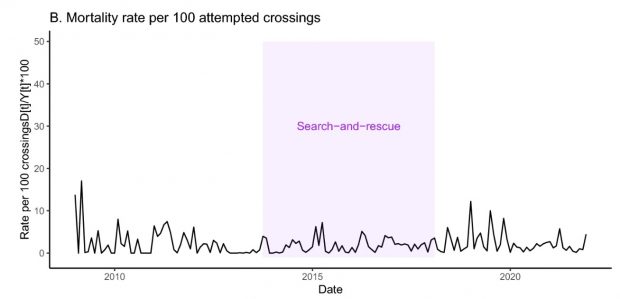
A comparison of the observed and predicted counterfactual time-series in the post-intervention periods suggest that pushback policies did affect the migration flow, but that the search-and-rescue periods did not yield a discernible difference between the observed and the predicted counterfactual number of crossing attempts.
So there is push but no pull.
A true hero, true scientist who saved millions of lives: Anthony Fauci
If I become a punching bag, I’m a punching bag. But I am very happy to testify before any congressional oversight committee, I have nothing to hide, I can explain and validate everything that I’ve done.
during an interview in a new episode of “Who’s Talking to Chris Wallace” – more at the Atlantic
I have a new book on my desk that covers most aspects of the recent discussion around research integrity in 60 chapters arranged in 14 sections.
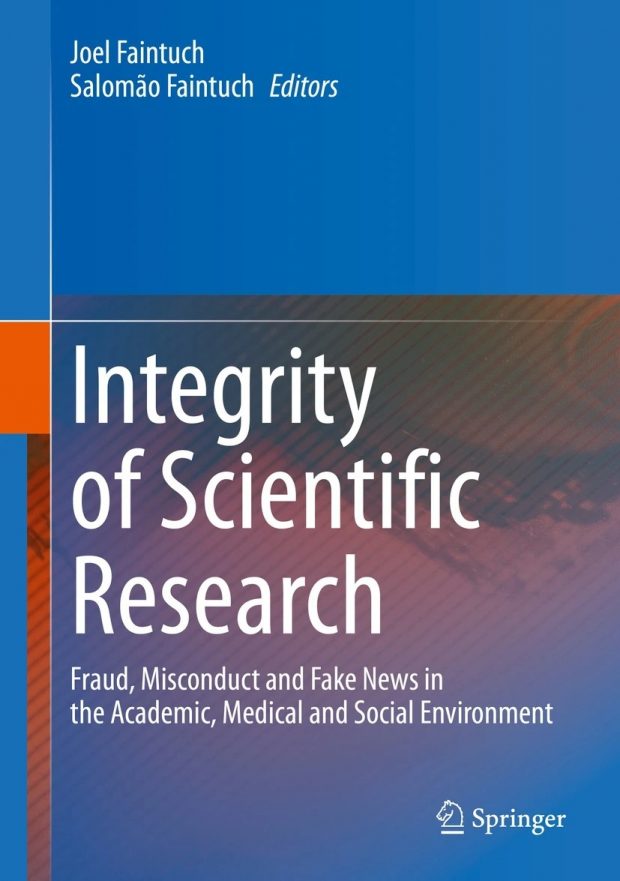
It is a comprehensive overview of research integrity across disciplines. Maybe some chapters are not written by the leading experts in the field. And maybe the scope is super-broad with several off topic chapters like corruption in healthcare or repetitive texts in subdisciplines like dental care. Unfortunately this comes at the cost that other chapters like image integrity are completely missing, while even PubPeer is not mentioned in the appendix. Also a keyword index would be nice. Nevertheless it is the largest body of text so far and should be on every desk that deals with science integrity. There are numerous highlights that cannot be found anywhere else like a comprehensive list of all paper rejection statements (p 412). So I will have to read it again next year.
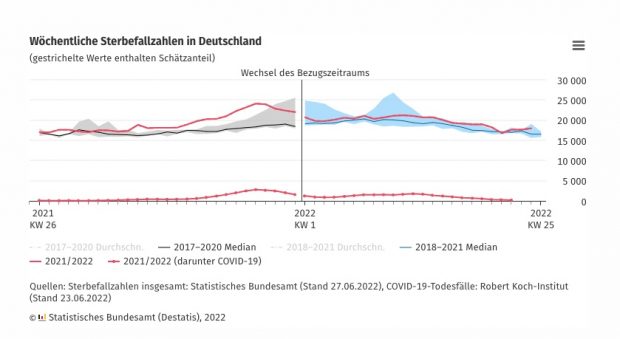
Das Thema COVID-19 Übersterblichkeit interessiert in der Öffentlichkeit nicht mehr groß, ausgenommen einiger SZ Redakteure — vermutlich weil die aktuellen Infektionsraten wieder niedrig und die Klinken voll, aber nicht überbelegt sind.
Für Epidemiologen ist die Übersterblichkeit aber dennoch alarmierend – auch wenn es keine direkten Coronatoten sind (wie in meinem nächsten Artikel in BMC über die Case fatality). Natürlich gibt es auch indirekte Todesfälle, etwa durch verpasste Therapien, dazu kommen andere Infektionen, Hitzewelle im Sommer oder auch psychosoziale Nachwirkung durch die Lücke welche die Corona Sterbefälle hinterlassen haben.
Was jedoch sehr wahrscheinlich ist, sind dazu auch Todesfälle durch Long Covid
We show that, beyond the first 30 d after infection, individuals with COVID-19 are at increased risk of incident cardiovascular disease spanning several categories, including cerebrovascular disorders, dysrhythmias, ischemic and non-ischemic heart disease, pericarditis, myocarditis, heart failure and thromboembolic disease.
Leider ist die Datenlage in Deutschland zu schlecht, um diese Auswertung aus den USA zu wiederholen. Impfen hat jedenfalls vor Tod geschützt – so auch das Ergebnis der SZ Auswertung – aber auch nach Impfung gibt es leichte Verläufe die noch Opfer fordern.
Die indirekten tödlichen Folgen der Corona-Infektion kann die Impfung hingegen weniger gut abwenden, weil sie leichte Verläufe nicht verhindern kann. „Auch eine leichte Corona-Erkrankung birgt noch ein Jahr nach der Infektion ein erheblich erhöhtes Risiko für Herzprobleme“, sagt Martin Korte.
Ausriss von https://www.wissenschaft-im-dialog.de/blog/blogartikel/beitrag/ich-bin-ein-misfit/
Es geht darum, Handlungsräume zu beschreiben und loszulaufen. Ob und wie viele Menschen mitkommen, liegt außerhalb unserer Macht. Aber Dankbarkeit für das Leben und Verantwortung für seinen gesunden Erhalt zu übernehmen, auch wenn wir nicht wissen, wie das Morgen wird, ist eine schöne Energie und bereichert das Jetzt.
(Maja Göpel)
Albert Einstein in einem Brief an Paul Epstein
A legendary tale of the dying Twitter imperium
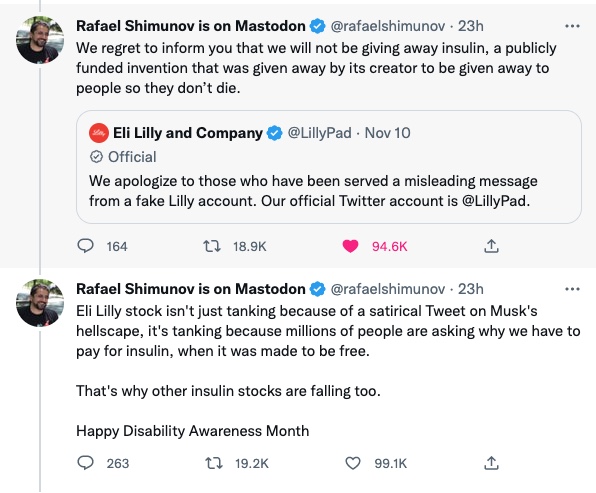
And well, parody everywhere…
